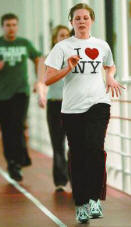Eating Disorders Prey on Girls
Student tells story of anorexia and bulimia struggle, success
 Sherri Barber/The Coloradoan
Sherri Barber/The Coloradoan
In Control: Jenna Radovich, 20, runs on the track at Colorado State University's Recreation Center. Radovich, who is a junior at CSU, suffered from anorexia and bulimia starting at the age of 17. She has had the disorder under control for two years
She was encouraged by an American culture that experts say admires excess and pushes extremes, but the behavior that was gaining Jenna Radovich's admiration was taking her from happy to miserable, from a women's size 6 to children's clothes, and from healthy to obsessed with food and exercise.
"I started losing weight and someone mentioned it," said Radovich, a 20-year-old junior at Colorado State University. "To me that meant that, before, I hadn't been presentable or something."
As her eating disorder progressed, people Radovich knew asked her, "How'd you do it?" and told her they wished they could look like that. They told her she must be so happy.
Overexercising and throwing up, however, was not making her happy.
"The only time I would cry is when I was over the toilet," said Radovich, who two years ago recognized she had an eating disorder and sought help from counselors, family and friends.
It was the summer before her senior year at Pomona High School and Radovich, a centerfielder, was excited about the fall softball season; she wanted her last year of softball to be her best.
That same summer, her dentist removed her wisdom teeth and for five days, Radovich couldn't eat solid foods. She said she lost weight and gained attention.
"I didn't notice anything until people said stuff, and then I kind of liked it," Radovich said. "That definitely kept the cycle going."
During her junior year of high school, Radovich started measuring her meals - literally, with measuring cups - after reading a fitness magazine article about Americans and their misconceptions about portions.
"I never had more than a cup of anything," Radovich said
Soon, however, she had cut that to a half-cup. Friends kidded her that Fitness magazine was her Bible.
Her mother, Mille, had suspected that her daughter might have body image problems, but the food measurement was the "biggest giveaway."
"I knew we had crossed that line," Mille said.
Still, Radovich's grades improved. Her social life was good. On the outside she didn't seem to be suffering. Her friends were concerned, but Radovich said she tricked them simply by eating ice cream.
To maintain energy for softball, Radovich "had to eat." She started exercising excessively to combat eating, something physicians call exercise bulimia.
Radovich would drive home after school, then run about three miles back to softball practice. After three hours of practice, she would run another one to three miles.
"I was basically starving my body ... using exercise," Radovich said. "Because I was an athlete, it was looked at in a good way."
But she was getting light-headed in class in the mornings and once passed out when she stood up. Doctors tested her for diabetes but didn't notice she had dropped 20 pounds.
During her senior year of high school, she wrote a 27-page research paper for an English class about exercise addiction. Still, it would be another year until she recognized the symptoms of an eating disorder that was ruining her life.
The youngest of three girls, Radovich grew up trying to keep up with her older sisters.
"She skipped over childhood toys and went straight to Barbies because they were into those sorts of things," Mille Radovich said.
"Of all my daughters, I never thought it would be her," Mille said.
Women have long been pressured to stay thin, said Dr. Jane Higgins, staff physician at Hartshorn Health Center at CSU for more than 17 years.
"I think it's always been normalized," Higgins said. "How many magazines don't have articles about losing weight?"
Fast facts
- Out of millions of Americans diagnosed with eating disorders annually, 90 percent are adolescent and young women
- Eating disorders have doubled since the 1960s and are increasing in younger age groups, as young as 7 years
- 40-60 percent of high school girls diet
Source: Journal of the American Academy of Child and Adolescent Psychiatry
The No. 1 wish of girls 11-17 years old is to lose weight, according to Margo Maine's "Body Wars: Making Peace with Women's Bodies."
As many as one-fifth of people with an eating disorder die from the illness, according to Eating Disorders Coalition, an advocacy group created to promote awareness of eating disorders as a public health priority.
Up to 3.7 percent of females suffer from anorexia nervosa, while as many as 4.2 percent of females have bulimia nervosa, according to the EDC. Nearly 4.5 percent of female and 0.4 percent of male college freshmen report bulimia in their first year of school
About nine out of every 10 people with an eating disorder are girls or young women, though 19-30 percent of young anorexic patients are male, according to the American Psychiatric Association.
In people with bulimia, between 50 percent and 70 percent of patients who received psychological treatment and medication recovered in the short-term, according to the APA. Other studies suggest that 30 percent to 50 percent of patients relapse six months to six years later, according to the APA.
CSU's Higgins said many of her patients see at least a short-term recovery.
"I think we see lots of success, or I wouldn't do this," Higgins said.
Other studies show that the biggest risk factor in people who develop eating disorders is dieting, said Danielle Oakley, a licensed psychologist and group coordinator at the Colorado State University counseling center. That's "pretty scary" given that 91 percent of girls and women between 14 and 18 are dieting, Oakley said.
"It's absolutely a body image issue," Oakley said.
Gyms and fitness centers can be breeding grounds for eating disorders, Oakley said.
"We tend to see it more in that gym culture in having the perfect body," Oakley said. "They're not thinking, 'Something's wrong here. I'm way too obsessed with this.' "
It was a flier on the wall of a CSU building that caught Radovich's attention during her freshman year of college. She was going to see her academic adviser when the flier, which had a list of eating disorder symptoms, "scared me."
"I was just looking at it saying, 'I do that, I do that, I do that,' " said Radovich, who was secretly throwing up in her dorm bathroom despite living with her closest childhood friend. "I called my sisters and said, 'I don't know what to do.' "
Her parents quickly set her up with a counselor in Westminster. Radovich said that to show support, her parents would drive from Arvada to Fort Collins, take her to the appointment in Denver and then drive her back to CSU; her parents would sit in the waiting room during her sessions.
"The hardest thing to say was, 'I'm struggling and I need your help right now,' " Radovich said.
Oakley said friends and family who approach people with eating disorders about getting help should be prepared for rejection.
"Don't let that discourage you from ever helping again," Oakley said. "Leave an open door for them to come back."
Also, avoid "anything that looks like you're taking that person's control," she said.
Mille Radovich knew she would have to pick and choose her chance to intervene with her daughter.
"She really is a strong, individual soul," Mille said. "Like most people, it has to be on you. She wasn't ready to hear, 'Jenna, you have a problem.' "
Nearly two years later, Radovich is recovering, though she says "it's a constant battle I deal with every day."
By the numbers- 42: Percent of first to third grade girls who want to be thinner
- 45: Percent of boys and girls in grades 3-6 who want to be thinner
- 9: Percent of 9-year-olds who have vomited to lose weight
- 81: Percent of 10-year-olds who are afraid of being fat
- 53: Percent of
- 13-year-old girls unhappy with their bodies
- 78: Percent of 18 year-old-girls unhappy with their bodies.
Source: From "Body Wars, Making Peace with Women's Bodies": by Margo Maine, Ph.D., Gürze Books, 2000
"I would not wish what I went through on my worst enemy," she said. "It was unhealthy, disgusting, and it was dragging me down."
Radovich, a health and exercise science major who wants to be a physical therapist, is a certified personal trainer at the CSU recreation center, where she sees many students going down the same road she traveled.
"If I wasn't as confident with who I am and where I've been, it would be really difficult (to work there) because it's all around you," Radovich said. "I feel like I can help."
Her hope is that she can be a resource for people stuck in the same cycle she fell into.
"What they think is helping them is hurting them."
Radovich will tell her story March 3 during Eating Disorder Awareness Month at CSU, another step in recovery and another chance to stop the spread of eating disorders.
Eating disorders and characteristics
ANOREXIA NERVOSA Description: Severe weight loss, fear of fatness, distorted body image, body image overemphasized in self-evaluation, loss of period.Characteristics: Emaciated look, physically active, profound weight loss, loss of menstrual period, body image distortion, fear of weight gain Medical complications: General health, cardiovascular compromise, osteoporosis, metabolic slowdown, multiple organ compromise, suicide In adolescence, growth retardation, delay of puberty, peak bone mass reduction Anorexia nervosa has the highest mortality rate of any psychiatric disorder, as high as 20 percent. Death can occur after severe binging in bulimia nervosa as well.
BULIMIA NERVOSA Description: Binging with a sense of loss of control followed by vomiting, laxative abuse, diuretics, extreme fasting or extreme exercise at least twice a week, body image overemphasized in self-evaluation. Sometimes food will be chewed then spit out.Characteristics: Individual "looks normal," binging and purging behaviors, individual overly concerned about body, secretive Medical complications: dehydration, heart problems, electrolyte disturbances, gastrointestinal problems.
BINGE EATING Characteristics: More prevalent: half of all clients of diet clinics are binge eaters, represented across all ages, equally represented between sexes, associated with problems of obesity Medical complications: cardiovascular, diabetes, musculoskeletal, infectious disease.
next: Eating Disorders: Know When to Seek Help for Your Child
~ eating disorders library
~ all articles on eating disorders
APA Reference
Staff, H.
(2008, December 25). Eating Disorders Prey on Girls, HealthyPlace. Retrieved
on 2026, January 10 from https://www.healthyplace.com/eating-disorders/articles/eating-disorders-prey-on-girls



